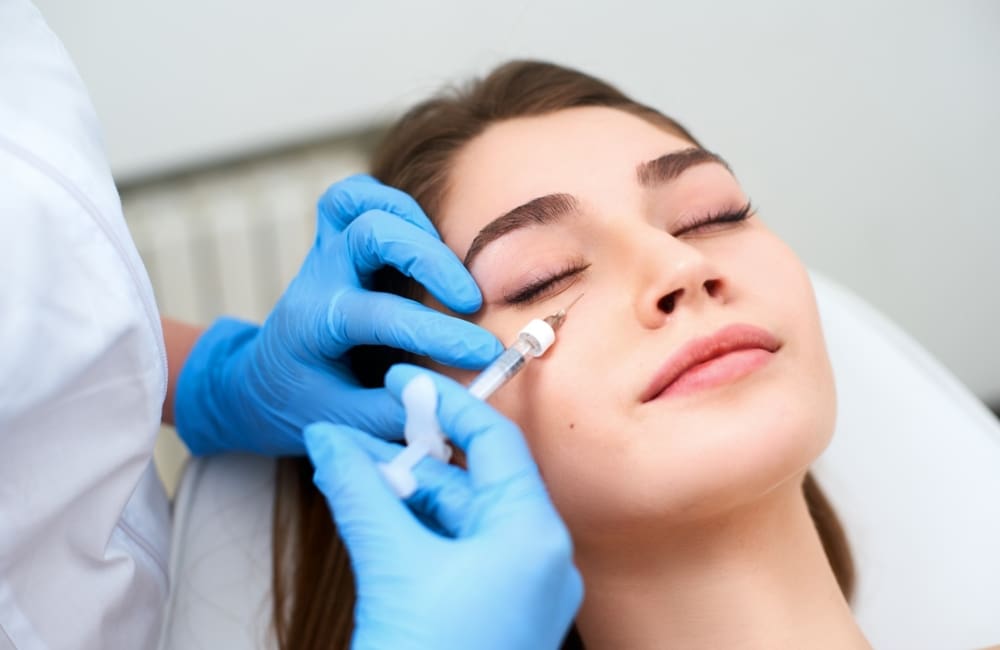Botox
How Long Do Tear Trough Filler Swelling Stages Last?
Tear trough filler is a treatment many people opt for to refresh their under-eye area. It reduces hollowness and dark shadows and helps give you a more rejuvenated look. However, like with any cosmetic treatment, it comes with side effects, the most common one being swelling.

Below is a complete guide on how long tear trough filler swelling lasts and tips on how to aid recovery and reduce discomfort.
Why Swelling Happens After Tear Trough Fillers
You may be wondering why there is so much swelling after you’ve had tear trough filler. While it may be alarming, there are actually a few perfectly reasonable explanations, and understanding them might put your mind at rest.
Reaction to Filler
Tear trough fillers include hyaluronic acid, and while this is a naturally occurring substance in the skin, when injected under your eyes, it can cause swelling. This is because it attracts water to the area, leading to puffiness that gradually goes down as the area absorbs the filler.
Trauma From Injection
It’s not every day you’re having needles injected into your under-eye tissue, so there is bound to be some irritation and trauma. You may experience micro-injuries from the small punctures in the skin, or there may be a capillary disruption, which causes fluid and blood to move into the surrounding tissue. They can cause swelling, yes, but neither is life-threatening!
Delicate Skin
Compared to other parts of your body, the skin in the under-eye area is particularly delicate and prone to swelling. This is because there is less fatty cushion, so when there is trauma or inflammation, it makes the effects of swelling much more visible.
Day-by-Day Swelling Timeline (First Week)
Preparation is key to any form of cosmetic procedure, and a form of preparation is knowing what’s going to happen afterwards. Here’s a complete run-through of the first week of swelling to help you know what to expect and look out for.
Remember that everyone is different, and not everyone’s healing process is going to look the same. That’s why it’s a good idea to use this as a rough guide, as not every day may apply to you exactly. We’ll provide some more information later on to help you look out for concerning side effects.
Day 1
The first day after your tear trough filler procedure will consist of the swelling immediately after the treatment. You’ll most likely notice swelling straight away. When looking in the mirror, your under-eye area will probably appear slightly puffy or overfilled. There may also be some redness and bruising. This is all completely normal, and it will go down.
If you want to look after your skin right after the injections, it’s best to apply a cold compress to minimise your puffiness. Avoid touching the treated area and keep it as clean as possible. Avoid any vigorous activities at least for the first day.
Day 2-3
After the first day after the treatment has passed, you’ll start to notice the swelling get slightly worse than before. This is because the next two days are considered the peak phase of the swelling timeline. Your appearance may seem a bit uneven, but this is only because you’ve reached the height of your body’s inflammatory response.
Follow the same tips as the first day to ensure a smooth recovery process. Some other things you can do to aid the additional puffiness are to sleep with your head slightly elevated to prevent fluid accumulation, and stay hydrated while limiting salty foods.
Day 4-7
After you’ve passed the peak swelling phase, you’ll finally start to see the swelling go down. It will happen quite quickly, and you’ll start to see the effects of the tear trough filler and go back to a more balanced and natural look. This is because your body has adjusted to the treatment, which minimises the inflammation.
It’s important that even though the swelling is subsiding, you still need to look after yourself and your skin. Continue following any advice given by your clinician or doctor, and follow the tips we provide for you further down.
When Should Swelling Subside Completely?
Although swelling subsides drastically once you reach day seven after treatment, it most likely won’t be gone fully at this point. For the next two to four weeks, you’ll still notice some puffiness; however, each day you’ll start seeing the final, rejuvenated look even more clearly. The filler will start integrating with your skin tissue much more seamlessly and reduce any leftover inflammation.
But when will the swelling subside completely? Well, there is no definite answer to this question because, as we mentioned earlier, everyone is different. However, the longest you should be looking for swelling is six weeks. For most, it will be around four weeks. By this time, you should be able to see your results clearly.
If you have reached six weeks and you are still having concerns about your swelling and puffiness, you should consult with your clinician. They will be able to suggest any causes and treatments to rid the swelling completely.
What’s Considered Normal vs. Concerning
Many people notice the swelling after the tear trough filler and immediately think something has gone wrong. As we have mentioned, it’s completely normal. However, there are signs that something to be wary of may be occurring. Here are some normal side effects and more extreme side effects to look out for during recovery.
Normal side effects
- Swelling: Mild puffiness around the injection site is common.
- Bruising: Small bruises can appear under the eyes, especially if capillaries are affected.
- Redness or tenderness: Localised discomfort or sensitivity can occur.
- Lumpiness or uneven texture: Temporary as the filler settles, often improves within days.
- Minor asymmetry: Often due to swelling and may correct itself as inflammation subsides.
Concerning side effects
- Severe or prolonged swelling/bruising (lasting more than 2 weeks)
- Tyndall effect: A bluish tint under the skin, indicating superficial filler placement
- Infection: Signs include increasing redness, heat, pus, or fever
- Painful lumps or nodules: Especially if growing, firm, or red
- Visual disturbances: Blurred vision, double vision, or vision loss – this is a medical emergency
- Skin discolouration or blanching: A sign of vascular occlusion (blocked blood vessel), which can lead to tissue damage
- Persistent asymmetry or irregularity: If noticeable after 2 to 3 weeks
Tips to Reduce Swelling and Promote Recovery
We briefly discussed how to aid recovery from swelling during the timeline. However, here are some additional tips to ensure you reach your final, rejuvenated look as quickly and seamlessly as possible:
Apply a Cold Compress
When you first receive treatment, you’ll experience slight discomfort, and the swelling will begin. During this time, you have to be especially gentle with your skin, and a cold compress is soft enough to help reduce puffiness. You can continue to apply it until your skin is less sensitive.
Drink Lots of Water
A body retaining a lot of water will have less opportunity to absorb the filler and reduce any swelling. However, if you continue to drink water and hydrate your body, you will be able to reduce this retention, as well as other toxins.
Avoid Vigorous Exercise
During the first week of recovery, you should avoid any excessive exercising as much as possible. This is because strenuous workouts or bending your body too far can cause your swelling to worsen. Only start increasing your exercise as you start noticing your swelling going down.
Remain Patient
It can be exciting getting tear trough filler, and you may want to see the results as quickly as possible. However, it’s important to remember that recovery is a vital part of the process, and you should remain patient while waiting for the swelling to go down.
When to Seek Medical Advice
Tear trough filler is a generally safe treatment, and you should have a smooth recovery process. However, any procedure comes with potential downfalls, which is why you should be vigilant in monitoring your side effects.
If you experience any of the following symptoms, you should seek urgent medical attention:
- Sudden vision changes (blurred vision, double vision, or vision loss)
- Severe eye pain or pressure that does not improve or gets worse over time
- Skin discolouration or blanching
- Signs of infection, such as redness that spreads, increasing warmth or swelling
- Lumps that are red, painful or growing







